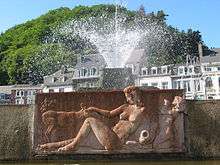Mineral spa
Mineral spas are spa resorts developed around naturally occurring mineral springs. Like seaside resorts, they are mainly used recreationally although they also figured prominently in prescientific medicine.
Origins
Spas were used for millennia for their purported healing or healthful benefits to those wealthy enough or close enough to partake of their waters. This was called a mineral cure and gave let to such phrases as taking a cure and taking the waters. There has always been a mixture of recreational and medicinal connotations involved, from rest and relaxation, stress relief, and convalescence to more specific notions such as humorism. These phrases are still sometimes used today as a euphemism for one trying to kick a drug dependency.
In many cases, mineral spas were located in mountainous locales that gave an additional excuse to leave the drudgery of a hot house in warm weather during summer's onset and were seasonally populated by the well-to-do. They eventually became early vacation spots with the counter-Victorian work ethic 'rationale' of health as an excuse to have fun and mix with one's peers in recreation.
Subsequently, many such became the seed stock for today's modern vacation resorts. Locations such as Steamboat Springs, Vail, St Moritz, Mineral Wells first became popular for the questionable health benefits of mineral or soda-water soaks, ingestion, and clean outs during the hey-day of patent medicines and backward medical knowledge. United States President Franklin Delano Roosevelt suffered a paralytic illness, and regularly visited Warm Springs and other hot springs for restorative soaks. While his cousin Theodore Roosevelt became known as a manly-man of incredible endurance, he was a sickly child suffering from asthma and 'took cures' periodically in an attempt to gain better health.
The name "spa" comes from the Belgian town Spa.
Evolution of the resort
As the Victoria era came to an end, the influences of the industrial revolution created more and more varied members of the upper middle class. The concepts of vacationing, tourism, and travel became less the property of the old monied classes, and shared by an increasing population base of those who could afford holiday trips like the rich.
Such adventures had much allure in the days before any audio-visual entertainments outside a live orchestra. Thus, the spas began attracting an increasing number of local patrons as well as those from afar just at the time when the burgeoning numbers were able to take advantage of the newfangled automobile and the now extensive railways throughout most all of Europe and the United States.
The Spa towns already had infrastructure and attractions in place to assuage such desires, and the modern tourist trip began to take its familiar form. Other technologies came into play (Skis, Ski boats, etc.)
Notable mineral spas and springs
- Main articles: Spa towns and List of spa towns
Africa
- Caledon, Western Cape, South Africa
- Tshipise, Limpopo, South Africa
- Bela Bela, Limpopo, South Africa
- Badplaas, Mpumalanga, South Africa
Asia
- Anshan, China
- Beppu, Ōita, Japan
- Gero, Gifu, Japan
- Yuseong-gu, Daejeon, South Korea
- Pamukkale, Turkey
- Ganeshpuri, Vajreshwari in Maharashtra, India
Europe


- Bad Fischau-Brunn, Austria
- Spa, Peshkopi, Albania
- Spa, Belgium
- Bankya, Bulgaria
- Banya, Plovdiv Province, Bulgaria
- Dobrinishte, Bulgaria
- Hisarya, Bulgaria
- Kyustendil, Bulgaria
- Narechen, Bulgaria
- Pavel Banya, Bulgaria
- Sandanski, Bulgaria
- Sapareva Banya, Bulgaria
- Varshets, Bulgaria
- Velingrad, Bulgaria
- Karlovy Vary, Czech Republic
- Luhačovice, Czech Republic
- Mariánské Lázně, Czech Republic
- Aix-les-Bains, France
- Dax, France
- Évian-les-Bains, France
- Tercis-les-Bains, France
- Vichy, France
- Borjomi, Georgia
- Baden-Baden, Germany
- Bad Neuenahr, Germany
- Wiesbaden, Germany
- Budapest, Hungary
- Hévíz, Hungary
- Krynica-Zdrój, Poland
- Nałęczów, Poland
- Baile Felix, Romania
- Baile Govora, Romania
- Baile Herculane, Romania
- Baile Tusnad, Romania
- Vatra Dornei, Romania
- Kislovodsk, Russia
- Pyatigorsk, Russia
- Yessentuki, Russia
- Korytnica kúpele, Slovakia
- Piešťany, Slovakia
- Trenčianske Teplice, Slovakia
- Bukovička Banja, Serbia
- Vrnjačka Banja, Serbia
- Radenci, Slovenia
- Saint-Moritz, Switzerland
- Yalta, Ukraine
Americas
- Caxambu, Brazil
- Harrison Hot Springs, Canada
- Tabacón, Costa Rica
- Milk River Bath, Clarendon, Jamaica
- Agua Hedionda, Mexico
- Termas del Arapey, Uruguay
- Desert Hot Springs, California, U.S.
- French Lick, Indiana, U.S.
- Hot Springs, Arkansas, U.S.
- Mineral Wells, Texas, U.S.
- Mount Clemens, Michigan, U.S.
- Poland Spring, Maine, U.S.
- Saratoga Springs, New York, U.S.
- Sharon Springs, New York, U.S.
- Steamboat Springs, Colorado, U.S.
- Warm Springs, Georgia, U.S.
- Warm Springs, Virginia, U.S.
- Berkeley Springs, West Virginia, U.S.
Oceania and Australia
- Hepburn Springs Australia
- Daylesford, Australia
- Peninsula Hot Springs, Victoria, Australia
- Hanmer Springs, New Zealand
- Rotorua, New Zealand
United Kingdom
England
- Askern
- Bath
- Boston Spa
- Buxton
- Cheltenham
- Church Stretton
- Dorton Spa
- Droitwich Spa
- Epsom
- Harrogate
- Ilkley
- Knaresborough
- Malvern
- Matlock
- Matlock Bath
- Royal Leamington Spa
- Royal Tunbridge Wells
- Scarborough See also The Spa, Scarborough
- Shap
- Shearsby
- Tenbury Wells
- Woodhall Spa